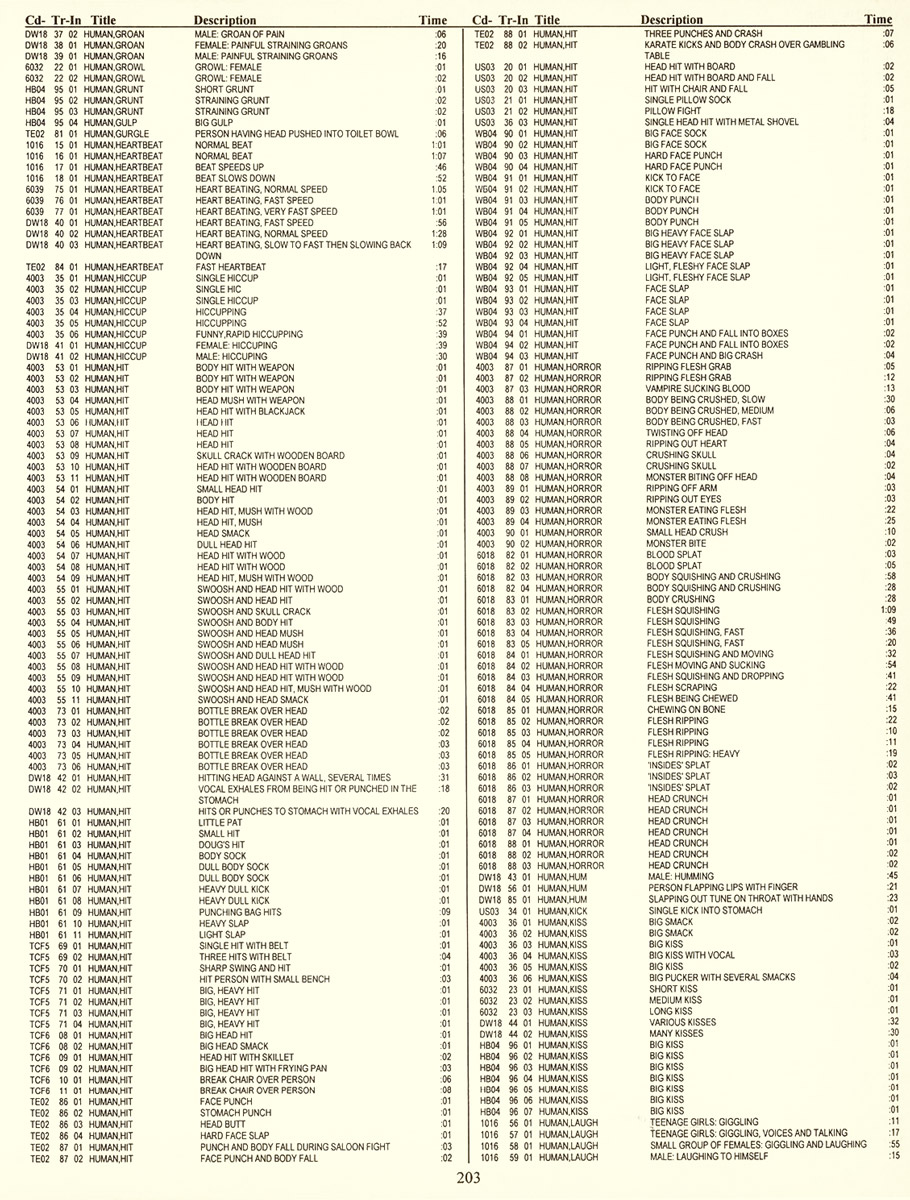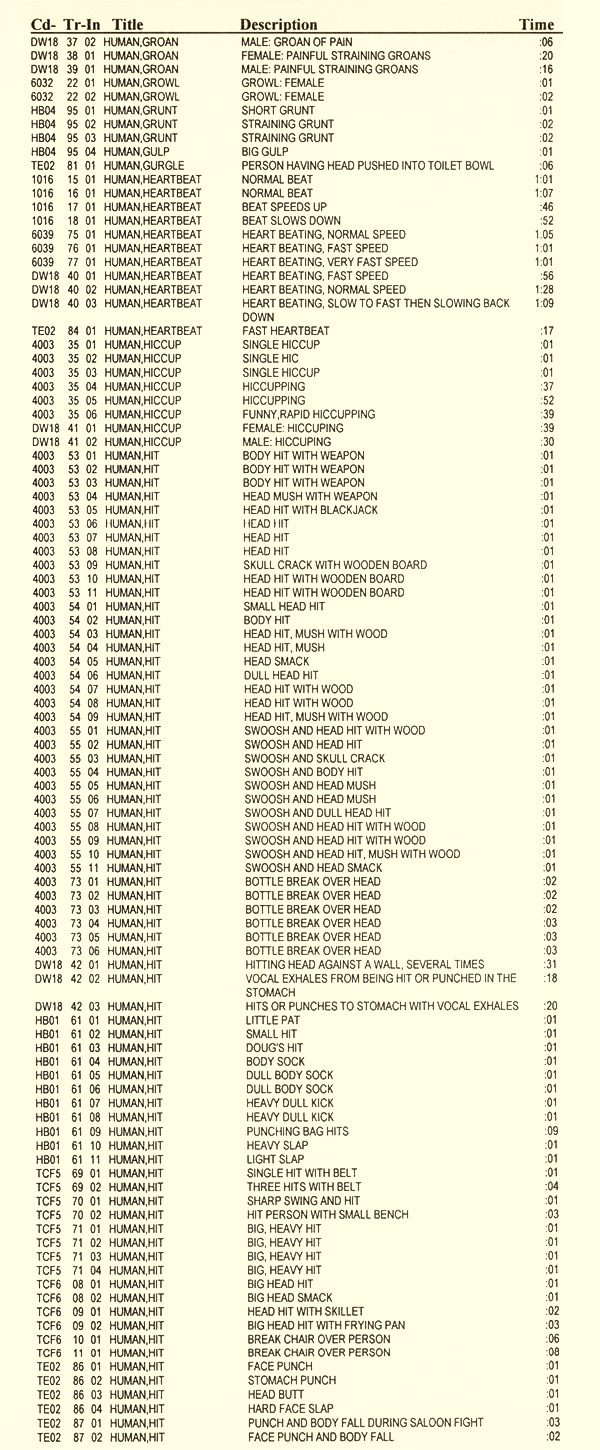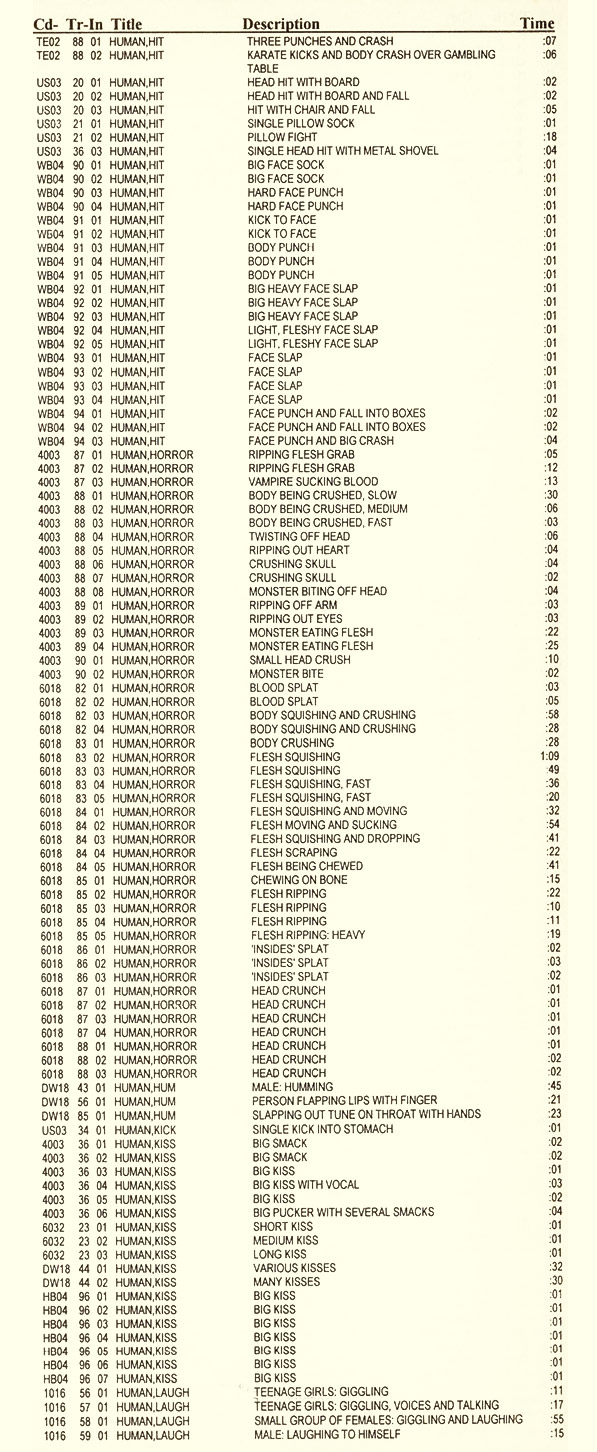Inventory / F Is for Foley
The indexical majesty of the sound effects catalogue
Anne Walsh & Chris Kubick
“Inventory” is a column that examines or presents a list, catalogue, or register.
Here, in its indexical majesty, is one page from a sound effects catalogue. We have chosen it from four pages devoted to “human” sounds in the 1996 edition of the Sound Ideas™ Sound Effects Library catalogue, published in Toronto, where the self-described “world’s largest publisher of sound effects” is based. In addition to the many thousands of sound effects they have produced themselves, Sound Ideas™ also licenses and distributes sound effects libraries from production companies such as Lucasfilm and 20th Century Fox. Among the many packages that Sound Ideas™ sells are a 45-CD set devoted to cars and trucks, 12 CDs devoted to wind, 5 further CDs devoted to whooshes, and a collection of 110 CDs that aims to serve as a general collection (and is called The General).

The sounds that Sound Ideas™ sells are used in films, TV commercials, and other productions, particularly ones with small budgets or tight timelines. When a producer decides that yet another car commercial will benefit from the screech of a red hawk in the background (freedom, fresh air, power, leather gloves…), a sound designer somewhere reaches for “Bird, Hawk // Red-Tailed Hawk: Single: Calling.” Purists may scoff, but there is a wonderfully cooperative logic to this “canned” sound archive: why should more than one person ever have to record the popping click of a 1962 Ford Mustang cigarette lighter?
It is presumably in this cooperative (if ultimately capitalist) spirit that Sound Ideas™ recently sent a young sound recordist to Europe for the summer armed with a substantial list of sounds that the Sound Ideas’™ braintrust had asked him to find and record. This type of list or “take sheet” is created with the idea that certain sounds will be desired by Sound Ideas™ clients for future productions—that is, sounds that are not only unique to specific European landmarks (“London, Big Ben, Bell Tolls x3”) but also sounds that quickly evoke their places of origin (“Poland, Ambience, shopping market w/ many Polish Voices”). When completed, this so-called “World Series of Sound” will include sounds from thirty-four nations and constitute a truly curious sort of Grand Tour-cum-documentary—not least because our Grand Recordist may not be out there listening to contemporary London or Berlin or Naples so much as listening for these cities’ pasts, one that someone has already heard (perhaps years before) and listed on a take sheet. (Will crowd sounds in the East African markets in Brixton be on the London take sheet? What about prayer time in the mosques of the East End? Or the polyglot crowds chatting on cell phones at the London Eye?) The sound effects catalogue is, it seems, less an archive of sounds than it is an archive of ideas and fantasies about sounds.
Webster’s defines sound effect as “an imitative sound, as of thunder or an explosion, produced artificially for theatrical purposes.” Does the fact of being named (and timed, described, classified, and numbered) render an “imitative sound” less trustworthy or “authentic” than any other type of sound? Or does it simply remind us, again, of the shifting, tragic, comically unbreachable gaps between different ways of knowing? There are stories embedded within sound effects, but we can’t really know what they are, even if the empirical evidence—the sounds themselves—is very specific. A sound is a sound is a sound, and “Human, Horror // Body Squishing and Crushing” may be what it says it is, but it’s more likely someone pulverizing a watermelon or the body of a dead chicken. F is for Fake but it’s also for Foley. Face Slap. Foreign, City. Fireplace. Ford Fairlane 500. Fizz. Footsteps. Forest, Tree Falling. Fondness…


Anne Walsh & Chris Kubick are San Francisco–based artists who work together collaboratively under the name ARCHIVE with a variety of formats and tools including performance, audio, video games, sculptural installation, and works on paper. From 2001–2004, ARCHIVE produced the project Art After Death, a wry hybrid of metaphysical storytelling, art history, biography, and autobiography. Recent venues for their performances and installations include the Royal College of Art, London; Yerba Buena Center for the Arts, San Francisco; and the Museum of Contemporary Art, Los Angeles.
Spotted an error? Email us at corrections at cabinetmagazine dot org.
If you’ve enjoyed the free articles that we offer on our site, please consider subscribing to our nonprofit magazine. You get twelve online issues and unlimited access to all our archives.